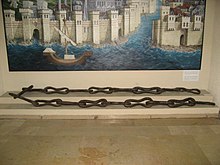Port chain
A port chain or power chain was a massive wrought-iron barrier chain that was carried by wooden floating bodies stretched along the surface of the water to prevent ships from passing. Its task was to prevent unauthorized or undesired shipping , such as entering or leaving the port or navigating a stream .
The chain that blocked the Golden Horn during the siege of Constantinople in 1453 became famous. Captured port chains were often carried away by the victors as war trophies. The city of Genoa kept the chains of the city of Pisa , defeated in the naval battle of Meloria in 1284 . The port chain of Marseille was brought to Valencia after the victory of Aragon in 1423 .
The chain tower of Damiette gained strategic importance during the Crusades . In the Kingdom of Jerusalem a court was responsible for maritime and shipping law as well as for the collection of tariffs as a "chain tariff" ( Cour de Chaîne ; Chaîne = port lock chain ). Another example is the Tour de la Chaine in La Rochelle.
During the raid on the Medway in 1667, the English could not prevent the Dutch fleet from entering the Thames and sunk or captured several English ships, despite a power chain (which was probably too deep in the water).
Individual evidence
- ↑ Leonardo Benevolo: The City in European History. Munich 1993, p. 57.
- ↑ Michel Mollat: Europe and the Sea. Munich 1993, p. 102.
- ↑ Hans Eberhard Mayer : History of the Crusades. 7th improved edition, Stuttgart u. a. 1989, p. 159.
Web links
- Chain in Pierer's Universal Lexicon. Zeno.org, 1860, accessed November 23, 2010 .

